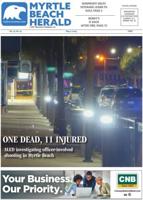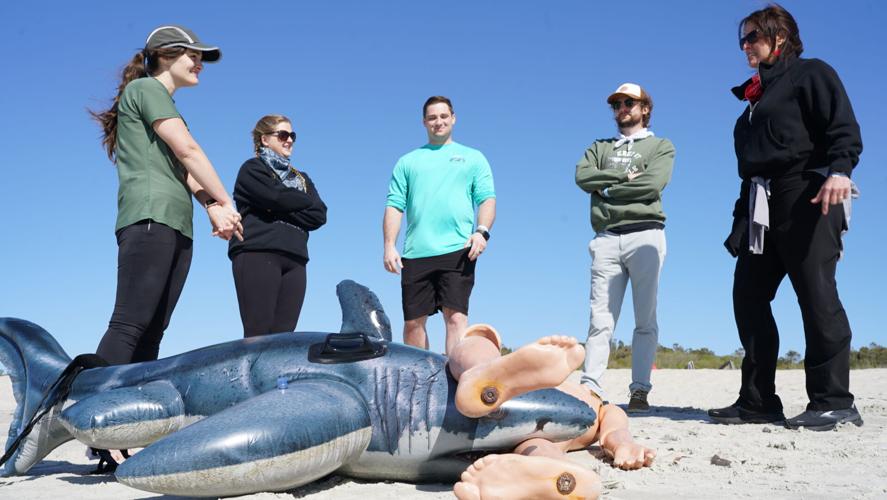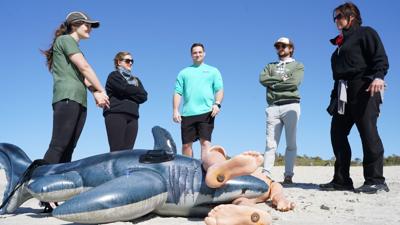Grand Strand Medical Centerâs emergency medicine residents learned to treat snake bites, shark bites, hypothermia and other emergencies during Wilderness Day at the Myrtle Beach State Park this month.
The residents rotated through eight emergency scenarios for hands-on training to challenge their expertise in environmental health throughout Wednesday morning, April 16.
Dr. Jarratt Lark, director of environmental medicine and toxicology, said treating snake bites, jellyfish stings, stingray envenomations and shark bites became his niche at the GSMC since arriving in 1992.
âItâs fun, this many years later. And to share it with this new generation of doctors in a fun way is good. I make fun of them, but at least theyâre learning something,â Lark said. â[Weâll] see how many I can trick into doing something they shouldnât do. This group wasnât really buying it.â

Dr. Jarratt Lark talks to Grand Strand Medical Center emergency medicine residents about the best ways to respond to snake bites at Myrtle Beach State Park Wednesday, April 16, 2025.
Lark led the station for a venomous snake bite and presented a dummy limb with a wound near the wrist and a variety of first-aid supplies.
The residents were to decide how to treat the wound. Some were inclined to use the tourniquet or ace bandage, but Lark said they would cause more damage to the local tissue around the wound.
However, a shark bite was demonstrated at a different station and tourniquets were the appropriate treatment option. In a shark bite situation, the priority is to stop blood flow to save the life of the victim rather than the limb, one resident said. One tourniquet is tied as tightly as possible two inches above the wound. The second is tied two inches above the first.
For snake bites, despite what popular culture might suggest, Lark said suction is not an effective solution.
âFirst of all, you donât want to put mouth bacteria there and youâre just causing more tissue trauma and it doesnât do anything. You donât get a significant amount of venom out,â he said.
The correct treatment option is the arm brace to reduce swelling, and the sling to keep the forearm horizontal which prevents the venom from flowing upward into the body or downward toward the wound.
Tylenol is preferred over Motrin for medicine before arriving at a medical center. Lark said Motrin sounds tempting because there is going to be a lot of inflammation and swelling, but it can accentuate the blood thinning effect. From there, walk calmly, try to keep your pulse steady and blood pressure low to get to safety.
The residents also identified a cottonmouth versus a banded water snake. The two species live amongst the same environment, but there are ways to identify what are venomous or non-venomous snakes.
Lark said a cottonmouth has vertically elliptical pupils, a pit because it is a pit-viper, a big triangle shaped head, and fangs. He added that venomous snakes have a single row of caudal scales and nonvenomous snakes have double rows of caudal scales.
Lark said the Myrtle Beach State Park is an environment where these injuries may happen and he said GSMC receives about half a dozen snake bite patients a year specifically from copperheads in the state park.
âMost venomous snakes hear you coming and they slither away. The copperheads know they have amazing camouflage. So, they donât slither away and just freeze and know you canât see them. And you donât see them, so you step on them and they bite you. Thatâs why we have so many copperhead bites,â Lark said. He added there were other stations focused on stingray envenomations and jellyfish stings.
Dr. Thomas Martel is an emergency physician at GSMC and said Wilderness Day gives the residents a break from the powerpoint lectures in the classroom and an opportunity to get outside. He said wilderness medicine focuses on treatment prior to EMS support and resources available in the hospital may not be available in an emergency situation.
âFor example, youâre hiking, you fall and you break your arm. I donât have a splint, but I have a stick and I have some string. Or I have a t-shirt I can rip up and make a splint out of it and now you have a splint,â Martel said.

Grand Strand Medical Center emergency medicine residents practice responding to a hypothetical hypothermia patient at Myrtle Beach State Park Wednesday, Aoril 22, 2025.
The residents, he said, will be doctors wherever they are, whether it is in a hospital or on a hike and this training expands their expertise.
Second year resident Aleah Lafrancis-Ream said Wilderness Day is her favorite day of the year as emergency medicine is a special interest of hers. She will be traveling to Honduras the following weekend as a global health elective for graduate medical education in emergency medicine.
âIt is a really resource-limited area so trying to figure out how to make do when you donât have the resources you have in a level one trauma center is kind of nice for us to learn how to do. It is more applicable to some of the places and situations we might find ourselves in,â she said.Â
Lafrancis-Ream is a part of the Wilderness Club and said they go on special trips to challenge themselves in various situations with limited resources. They camped out at Huntington, conducted water rescue scenarios in the Marshwalk, and made a trip to the Barrier Islands.
The club spent three days in the remote location, with no running water or electricity and were presented with various situations to expand their skills in wilderness medicine.









(1) comment
Does GS supply antivenom?
Welcome to the discussion.
Log In
Keep it Clean. Please avoid obscene, vulgar, lewd, racist or sexually-oriented language.
PLEASE TURN OFF YOUR CAPS LOCK.
Don't Threaten. Threats of harming another person will not be tolerated.
Be Truthful. Don't knowingly lie about anyone or anything.
Be Nice. No racism, sexism or any sort of -ism that is degrading to another person.
Be Proactive. Use the 'Report' link on each comment to let us know of abusive posts.
Share with Us. We'd love to hear eyewitness accounts, the history behind an article.